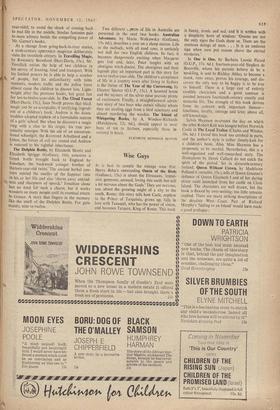Wise Guys
IT is best to sample the vintage wine first. Harry Behn's outstanding Omen of the Birds (Gollancz, 15s.) is about the Etruscans, 'impul- sive, generous, amused, loving this earth but still a bit nervous about the Gods.' They are nervous, too, about the growing might of a city to the south, Rome; this story tells how Caele, nephew to the Prince of Tarquinia, grows up, falls in love with Tanaquil, who has the power of vision, and becomes Tarquin, King of Rome. This book is funny, ironic and sad, and it is written with a simplicity born of wisdom: 'Omens are not the only signs the Gods show us. There are the ominous doings of men. . . . It is an ominous sign when men put reason above the eternal mysteries.'
In One is One, by Barbara Leonie Picard (O.U.P., 17s. 6d.), fourteen-year-old Stephen de Beauville, whom his parents believe to be a weakling, is sent to Richley Abbey to become a monk, runs away, proves his courage, and dis- covers the only way to be happy is to be true to himself. There is a large cast of entirely credible characters and a good contrast is pointed between fourteenth-century courtly and monastic life. The strength of this book derives from its concern with important themes— loneliness, loyalty, courage and love; above all, self-knowledge.
Sylvia Haymon re-creates the day on which the rebel Robert Kett was hanged before Norwich Castle in The Loyal Traitor (Chatto and Windus, 10s. 6d.). I found this book too cerebral in parts, and the author's style is rather closely-knit for a children's book. Also, Miss Haymon has a propensity to be morbid. Nevertheless, this is a well-organised and well-researched story. The illustrations by Derek Collard do not catch the spirit of the period. Set in sixteenth-century Ireland, Queen Without Crown, by Madeleine Polland (Constable, 15s.), tells of Queen Grainne's defiance of Queen Elizabeth I and of her daring pirate raids launched from her castle on Clare Island. The characters are well drawn, but the book is flawed by over-writing; too little remains implied. There are many striking descriptions of the desolate West' Coast. Part of Richard Murphy's 'Sailing to an Island' would have made a good prologue:
We point all day for our chosen island, Clare, with its crags purpled by legend: There under castles the hot O'Mallcys, Daughters of Granuaile, the pirate queen, Who boarded a Turk with a blunderbuss, Comb red hair and assemble cattle.
The Far-Off Land, by Rebecca Caudhill (Hart-Davis, 21s.), describes Ketty Petrie's two journeys: from a tranquil Moravian settle- ment to the French 'Lick,' where there was land for settlers; and from childhood to womanhood. Red Indians endanger one journey, personal antagonisms the other. The author's style, full of archaic expressions, is never easy, but always authentic, and powerful to boot. A moving and moral book. The Friend with a Secret (Collins, 15s.) is Angela Bull's first book for children. The voice of mid-Victorian England speaks in this solid, highly accomplished story. Miss Bull has a real understanding of how children inter- act, and the relationship between Master Nicholas, who makes out he lives an exciting life at school, and his sister Lucy, involved in real drama, is utterly compelling. Father and mother are endowed with the quintessential Vic- torian characteristics without being caricatures, and there is a splendid Austenian aunt.
I end with a brace of grouses. It really is time all publishers indicated, and indicated honestly, the intended age groups of their children's books. And last, four of these six books are over- priced. Sixteen shillings should be the maximum for this kind of children's book—and sixteen shillings only when it is illustrated and at least 200 pages long. Collins with Angela Bull's ex- cellent book) show the way.
KE YIN CROSSLEY-HOLLAND















































 Previous page
Previous page